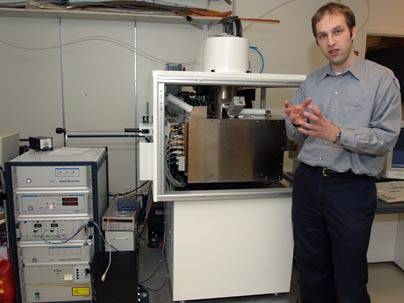MIT researchers have developed a tiny light detector that may allow for super-fast broadband communications over interplanetary distances. Currently, even still images from other planets are difficult to retrieve.
"It can take hours with the existing wireless radio frequency technology to get useful scientific information back from Mars to Earth. But an optical link can do that thousands of times faster," said Karl Berggren, assistant professor in the Department of Electrical Engineering and Computer Science (EECS).
Berggren, who is also affiliated with the Research Laboratory of Electronics (RLE), developed the detector with colleagues from the RLE, Lincoln Laboratory and Moscow State Pedagogical University.
The new detector improves the detection efficiency for single photos to 57 percent at a wavelength of 1,550 nanometers (billionths of a meter), the same wavelength used by optical fibers that carry broadband signals to offices and homes today. That's nearly three times the current detector efficiency of 20 percent.
The result will be real-time collection of large amounts of data from space. The work may ultimately permit the transmission of color video between astronauts or equipment in outer space and scientists on Earth.
The detector, which uses nanowires and superconductor technology, can sense extremely low light or laser signals in the infrared part of the optical spectrum -- down to a single photon, the smallest and most basic unit of light. That has not been possible using conventional optical systems.
The detector also could be applied to quantum cryptography and biomedical imaging, but the most immediate application is probably interplanetary communication, Berggren said.
Because of the vast distances between planets, current optical systems would require a large laser and a lot of power to send data at a high rate. And this would have to be done on spacecraft, which are typically starved for power. So there is a need for devices like the new detector that can operate quickly and, because they are more sensitive, receive signals from smaller lasers that do not use much power, Berggren said.
Single-photon detectors have been made by MIT and other researchers in the past, but they have not been both speedy and efficient at detecting light. The way Berggren and his colleagues improved the efficiency was to add a "photon trap" to the detector as well as an anti-reflection coating to keep light from bouncing off its surface.
The photon trap is an optical cavity consisting of the nanowire detector, a carefully measured gap of glass and a mirror. The nanowire is coiled tightly like the metal on the back of a refrigerator to broaden its area of overlap with the laser light.
The wire is then cooled to just above absolute zero. That temperature is the point at which it becomes a superconductor and at which it can detect the absorbed photons. If a photon is not absorbed the first time it touches the wire, it bounces back and forth between the coiled nanowire and the mirror so it has more opportunities to be absorbed. The more photons that are absorbed, the greater the efficiency of the detector.
Berggren and his colleagues published their discovery in the January 23 issue of Optics Express. His co-authors are MIT RLE post-doctoral researcher Kristine Rosfjord and RLE/EECS graduate students Joel Yang, Vikas Anant and Eric Dauler; Lincoln Laboratory staff member Andrew Kerman; and Boris Voronov and Gregory Gol'tsman of Moscow State Pedagogical University.
The researchers are now working to make the detector even more efficient.
This work was funded in part by the U.S. Air Force.
A version of this article appeared in MIT Tech Talk on March 22, 2006 (download PDF).







